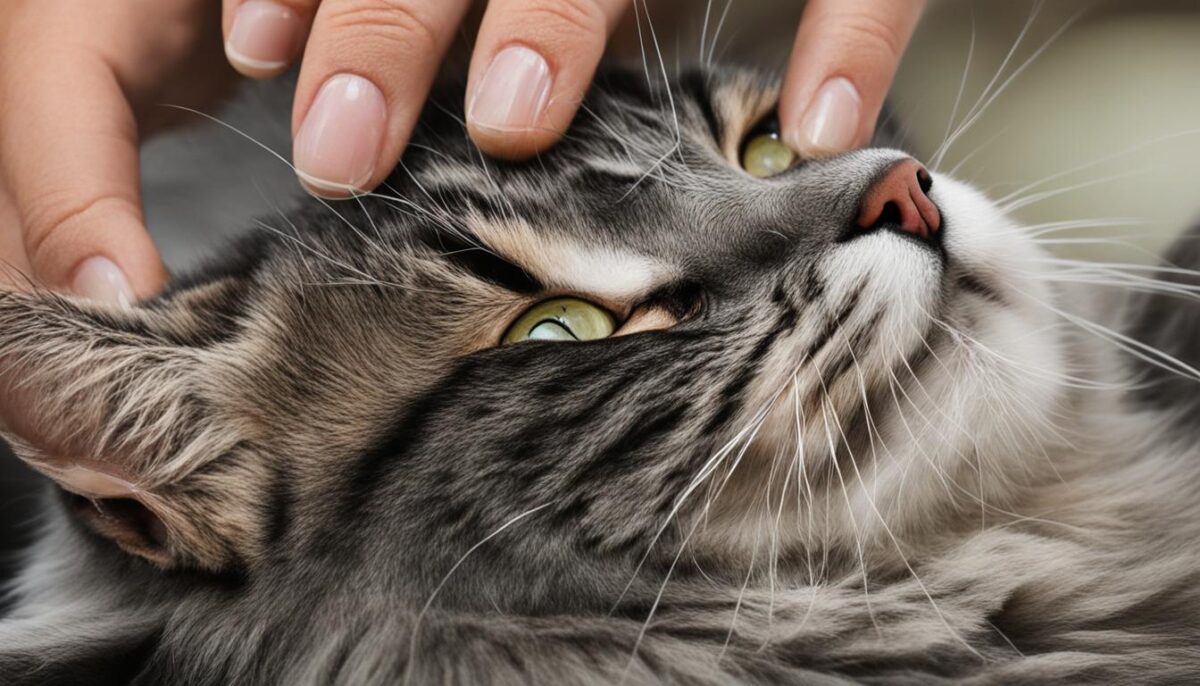Have you ever wondered about your cat’s health and how you can keep them safe from itchy skin conditions? Scabies prevention is an important part of pet care. As a caring pet owner, you should know about feline parasites that can make your kitty feel bad. Yes, cats can get scabies from tiny bugs called cat mites. This can make them scratch a lot and lose fur. If you see your cat itching more than usual or spot icky, flaky skin, it’s time for a trip to the vet. Keep reading to find out more about how to take care of your feline friend and protect them from mange in cats.
Key Takeaways
- Scabies in cats is caused by a very small bug called cat mites.
- If you see your cat scratching a lot and losing hair, they may have scabies.
- Protect your cat from getting scabies by keeping them clean and healthy.
- Other pets can get scabies too, and even you could get it from your cat.
- If you think your cat has scabies, visit the vet right away to help them.
Understanding Scabies in Cats
Scabies is a contagious skin condition if you’re a cat, it’s no fun at all. Scabies can make a cat’s skin super itchy and uncomfortable. Do you know what causes it? It’s all because of these tiny critters called skin mites, and the same kind can’t really make a home on people, but they sure can make your furry friend miserable.
So, how does a cat get scabies? These mites love going from one animal buddy to another. This means that scabies transmission is mostly through snuggling up with or even being near other animals that already have these itchy mites. And yes, if your cat likes roaming outside where wildlife hangs out, that’s a big ‘hello’ sign for mites!
What happens when these mites hitch a ride on your cat? Well, they like to dig down under the skin to lay their eggs, starting the mite life cycle. This can cause some not-so-nice red spots, flaky patches, and your cat might even lose some hair. Don’t worry, though. Your vet can take a close look at your cat’s skin to see if scabies is the troublemaker.
Remember, since scabies in cats is one of those contagious skin conditions, it’s really important to keep an eye on all your pets to make sure everyone stays happy and healthy.
- Keep your cats indoors if you can, so they don’t meet mites on their adventures outside.
- Say yes to vet check-ups to keep those pesky mites away.
- If your cat’s skin looks red or they’re scratching too much, a vet trip is a good idea.
Don’t let scabies make your cat feel scratchy and sore. Knowing about these sneaky skin mites helps you protect your feline family member. Stay alert and give your pet lots of love and care!
Common Causes of Feline Scabies
When your outdoor cat comes home with itchy skin, it might be more than just fleas. Tiny bugs called mites can cause a big problem called mite infestation.
Identifying the Mites Responsible for Scabies
The itchy annoyance in cats is often due to a very small mite known as Notoedres cati. This mite can easily be passed between cats. But there are other mites too, like Sarcoptes scabiei that usually affect dogs, or even Demodex mites that live on the skin but sometimes cause trouble.
How Outdoor Activities Lead to Mite Infestation
If your cat likes to wander outside and explore, it may meet other animals. This is how cats can get scabies, by rubbing noses with a friend who has these irritating mites. If another animal has mites and your cat gets close, mite transmission can happen. Outdoors is fun for cats, but it can also bring these unwelcome guests.
Keep an eye on your furry friend. Mite infestation can cause a lot of discomfort and change the way their skin and fur look. No one wants that for their beloved pet. Remember, a happy cat is one that stays healthy both inside and out!
Recognizing Symptoms of Scabies in Your Cat
When your cat has scabies, it’s like they have little bugs on their skin that you can’t see. These bugs make them itch a lot and feel very uncomfortable. Your cat may scratch, lick, or bite its skin a lot because of these bugs. This is a sign that something is not right, and your cat needs your help. Let’s look at the signs that tell us your cat could have scabies.
Visible Signs of Discomfort
Your kitty might start to act differently if it has scabies. It might scratch itself more than usual or seem restless because of the itchy skin. Sometimes, you will see your cat shake its head a lot, or they might not like to be touched in areas where it hurts.
Remember, to see if your cat might have a skin problem like scabies, watch how much it scratches or grooms itself. An increase in cat grooming behavior is a strong hint that they’re trying to soothe their skin irritation.
Changes in Skin and Coat Appearance
If your cat has scabies, the skin can look different than normal. You could see some hair loss, mostly near the head, ears, and neck. Your cat’s skin might have a greasy feel or look a different color. You might even notice bumps or scabs. These changes in the skin and coat are reactions to the scabies and a sign that your cat feels bad.
If you think your cat might have scabies because of these signs, it’s very important to go to the vet. They can tell you for sure if it’s scabies and help your cat feel better with the right treatment.
Effective Treatments for Scabies in Cats
If your kitty has scabies, don’t worry! There are treatments that can help make your furry friend feel better. The vet will usually choose anti-parasitic medications that work really well against the tiny bugs causing the itch. These might be spot-on liquids, pills for swallowing, or even shots. Remember, your cat might need these treatments more than once to chase away all the mites.
Along with medications, the vet might suggest special shampoos to calm the skin. Sometimes, if the scratching has made the skin sore, your cat might even get an antibiotic. And since these mites can spread, your vet will talk to you about taking care of your home too—like washing the bedding in hot water and cleaning up the areas where your cat likes to nap. This helps keep everyone in the house happy and healthy!
Getting rid of scabies is a team effort, and that includes you, veterinary care experts, and even other pets at home. So with the right mange treatment, your cat will be back to its playful, cuddly self in no time!
Conclusion
When you notice your cat is not feeling well, acting fast is very important. If your cat starts scratching a lot or you see changes in their skin or hair, these could be signs of scabies. Getting your cat checked by a vet right away is key. This can stop the mites from making your pet sicker and keep the mites from spreading. Your vet will tell you the best way to make your cat better and can give medicines to kill the mites. This is what we call an early diagnosis.
The Importance of Swift Diagnosis and Treatment
When a vet sees your cat quickly, they can figure out if it is scabies. Then, the vet can start the right treatment. This helps your cat feel better sooner. Treating scabies fast is good for keeping pet mite protection up and stops the mites from going to other pets or people. Remember, a healthy cat is a happy cat!
Preventative Measures to Protect Your Cat
Stopping scabies before it starts is a big part of taking care of your cat. By giving your cat medicine regularly, like a spot-on or a spray, you can keep mites away. This is known as preventing scabies. Also, keep your cat’s bed and play areas clean to keep mites from living there. Always talk to your vet for the best advice on veterinary care tips to keep your furry friend safe from scabies. They will help you find out the best way to care for your cat.
FAQ
Can cats get scabies?
Yes, cats can get scabies, a skin condition caused by the mite Notoedres cati. It’s a form of feline parasites that leads to severe itching, redness, and hair loss.
How do cats contract scabies?
Cats can contract scabies through direct contact with other animals that are infected. This includes wildlife or other domestic pets. Outdoor cats are especially at risk due to their higher likelihood of encountering infested animals.
What are the common causes of scabies in cats?
Scabies in cats are primarily caused by the Notoedres cati mite, but other mites like Sarcoptes scabiei and Demodex can also lead to similar symptoms. Cats usually pick up these mites from the outdoors or from contact with other infected animals.
What are the signs that my cat may have scabies?
Signs of scabies in cats include persistent scratching, excessive grooming, hair loss, especially around the head, ears, and neck, and changes in the skin like redness, flaky patches, or bumps.
What is the treatment for scabies in cats?
Treatment for scabies in cats involves anti-parasitic medications that could be administered as spot-on treatments, oral tablets, or injections. Your veterinarian might also recommend medicated shampoos, anti-inflammatory medications for itching, and sometimes antibiotics if there is a secondary skin infection.
Is scabies contagious to humans or other pets?
Yes, scabies can be contagious to humans and other pets. It’s why prompt veterinary care for your cat and environmental management, such as cleaning bedding and living areas, is crucial to prevent the spread of mites.
How can I prevent my cat from getting scabies?
Preventing scabies in your cat involves regular parasite prevention treatments, which could include spot-ons, tablets, or sprays. Keeping your cat’s living environment clean and minimizing contact with potential sources of infestation is also important. Always consult your veterinarian for the most suitable preventative measures for your feline friend.
What should I do if I suspect my cat has scabies?
If you suspect your cat has scabies, you should take them to the veterinarian as soon as possible for a diagnosis. Early detection allows for more effective management of the condition and reduces the risk of spreading the mites.


